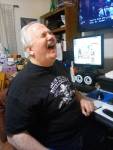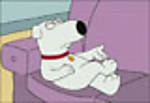
About 20 minutes of Xacto-twiddling into this project, the knife slipped and plunged into my left index finger. Being a spaz, I generally do that at least once per model, and the Missus always gets queasy when I use Krazy glue to seal the wound. Whew. At least that's over with. Now, full steam ahead with the build.
I am, frankly, quite thrilled with this model, and Roden has broken new ground. Although the 1920s was probably the most critical period in aviation history, it is the era least catered to among kit manufacturers. The workhorses were the modified two-seaters in designs left over from the Great War, the planes that did the grunt work of training, of exploration, of mapping, of making the air a viable workplace in the new age. The Mk. IV "Biff" was right in the thick of it, keeping the peace in the far reaches of Empire whilst also training a new generation of air-minded cadets in Britain's universities. In one form or another, the doughty Bristol Fighter served for a quarter-century, longer than any other British design on World War I.
This Bristol Mk. IV kit is likely the first 1/48 utility biplane released by a major company since Aurora's M-2 "Mailplane," a half-century ago. Roden has already knocked out an attractive DH.4a "passenger" modification, and I'm sincerely hoping they'll get around to more post-war DH-4s, DH-9a, Wapiti, Fokker C-1 … how about a Bristol Tourer? All based on kits that have already been released by Roden. (Oh, while I'm dreaming, how about the Hawker Hart family?) All also widely used by a variety of air forces.
Stephen Lawson (JackFlash) gave us a complete preview of what to expect in the kit. Suffice to say that it is Roden's basic Bristol Fighter, with an extra tree of parts and a new decal sheet to modify it to Mk. IV standards, which is exactly what happened to the real bird. Lawson also thoughtfully forwarded Eduard's Sutton seatbelt harness. necessary for a postwar bird.
The additional sprue contains the more-streamlined cowl, with stamped louvers instead of open holes, a different radiator face, enlarged tailfeathers and long, straight exhausts, slightly modded tailskid bracing, and Handley Page slats and gears for the upper wing (the mold for which has been modified to accept the slats), plus assorted gimcracks for the message-pickup apparatus.
The decal sheet provides markings for a colorful Bristol Fighter of the Cambridge University Air Squadron, circa 1931, plus a drab Army Cooperation Squadron bird in 1930. They seem well-printed and accurate. They also require the modeleer to make a choice early on. A clean, well-maintained University plane, or a dusty, knocked-about soldier in overseas service.
Roden doesn't provide enough goodies, alas, to do the latter. Perhaps in a later issue, Roden can provide a small sprue tree with Holt flares, extra wheels and radiator, under-wing luggage panniers, tropical secondary radiator, wide-tread tires, proper Cooper racks, generators, cameras to attach to the Scarff Ring mount, maybe even a trussed antelope to tie to the wing. Biffs in overseas service tended to have all sorts of junk attached to the outside; the clutter is one of the visually appealing aspects of its historic appearance. (Roden, if you do this, dudes, throw in some Mexican, Peruvian, Afghani, Greek, New Zealand and Norwegian markings!)
Without the provided clutter, a clean machine is the fallback, and so the attractive Cambridge University mount it will be. (Mainly because I'm fond of the Cambridgeshire countryside, but that's another story.)
Next step, how serious a build will this be? On the scale of an out-of-the-box weekender up to a never-finished, compulsive-detail disorder assembly, I decide my Mk. IV will be pretty much OOB, with the only things "fixed" being the stuff I can't help myself from tweaking.
That's partly practical. I have not built Roden's Biff before, despite having several on the shelf. Do a simple build and see how it goes, then go crazy on the detail stuff when you have time later. Maybe in your second lifetime.
Except, as noted, for the bits that MUST be fixed. Which brings us 'round to the cut finger. The pilots' seat is woven wicker on the real bird, and Roden provides a simple seat shell. No problem, thinks I, reaching for my Eduard brass fret of generic WWI seats. Alas, none of them resemble the Brisfit seat. So out comes the knife for a bit of twiddling and — ouch!
Next up, the adventure of adding photos to this build blog.











































